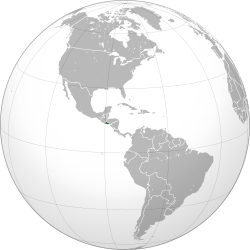
.
/ɛl ˈsælvədɔːr/
‘spanish’ –> [el salβaˈðor]
.
(‘el salvador’ officially the Republic of El Salvador (Spanish: República de El Salvador, literally “Republic of The Savior”)
.
, is the smallest and the most densely populated country in Central America)
El Salvador’s capital and largest city is San Salvador.
As of 2015, the country had a population of approximately 6.38 million, consisting largely of Mestizos of European and Indigenous American descent.
(why did the spanish mix with the indians to a much higher degree than the british?)
El Salvador was for centuries inhabited by several Mesoamerican nations, especially the Cuzcatlecs, as well as the Lenca and Maya.
In the early 16th century, the Spanish Empire conquered the territory, incorporating it into the Viceroyalty of New Spain ruled from Mexico City.
In 1821, the country achieved independence from Spain as part of the First Mexican Empire, only to further secede as part of the Federal Republic of Central America in 1823.
Upon the republic’s dissolution in 1841, El Salvador became sovereign until forming a short-lived union with Honduras and Nicaragua called the Greater Republic of Central America, which lasted from 1895 to 1898.
From the late 19th to the mid-20th century, El Salvador endured chronic political and economic instability characterized by coups, revolts, and a succession of authoritarian rulers.
Persistent socioeconomic inequality and civil unrest culminated in the devastating Salvadoran Civil War (1979–1992), which was fought between the military-led government and a coalition of left-wing guerrilla groups.
The conflict ended with a negotiated settlement that established a multiparty constitutional republic, which remains in place to this day.
El Salvador’s economy was historically dominated by agriculture, beginning with the indigo plant (añil in Spanish), the most important crop during the colonial period, and followed thereafter by coffee, which by the early 20th century accounted for 90 percent of export earnings.
El Salvador has since reduced its dependence on coffee and embarked on diversifying the economy by opening up trade and financial links and expanding the manufacturing sector.
The colón, the official currency of El Salvador since 1892, was replaced by the U.S. dollar in 2001.
As of 2010, El Salvador ranks 12th among Latin American countries in terms of the Human Development Index and fourth in Central America (behind Panama, Costa Rica, and Belize) due in part to ongoing rapid industrialisation.
.
(however, the country continues to struggle with high rates of…)
‘poverty’
‘inequality’
‘crime’
.
.
.
.
👈👈👈☜*back to “CENTRAL AMERICA”* ☞ 👉👉👉
.
.
💕💝💖💓🖤💙🖤💙🖤💙🖤❤️💚💛🧡❣️💞💔💘❣️🧡💛💚❤️🖤💜🖤💙🖤💙🖤💗💖💝💘
.
.
*🌈✨ *TABLE OF CONTENTS* ✨🌷*
.
.
🔥🔥🔥🔥🔥🔥*we won the war* 🔥🔥🔥🔥🔥🔥
